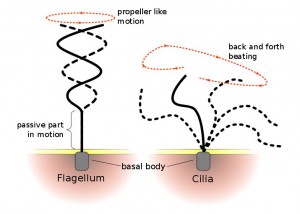
Transportation by hairs called flagella and cilia? Yes, either works. What are they and how do they function?
One-celled animals want to get around, too. One method used by the amoeba seems very innovative. Basically a liquid-filled blob, the amoeba directs some of its protoplasm to form pseudopodia, which is a 50-cent word meaning false feet.
Other protozoa possess what is called a flagellum (some use two flagella). These are long hairs, sometimes longer than the body of the animal. It moves through the water using the flagellum like a whip.
Yet others use a collection of shorter hairlike organelles called cilia.
What is the difference between flagella and cilia? The differences may be seen when they are carefully observed under a microscope. Brooklyn College provides excellent images for both, here.
Flagella
There is more than one variety of flagellum. These structures are not for locomotion alone, but also serve as sensors. For one thing, they determine the presence of moisture. They are also sensitive to temperature and chemicals. Flagella can rotate or undulate in sinusoidal motion and thus resemble a kind of corkscrew/extended propeller.
The University of Illinois tells us that bacteria have three parts to their flagella: an ion driven motor, a hook resembling a universal joint, and a long filament. Within the filament are long pairs of microtubules that slide past each other to impart filament shape.
When the motor rotates in one direction, the flagellum moves one way. When it rotates in the other direction, the flagellum behaves differently. Combining the alternate directions as needed, the animal is capable of moving to wherever it wishes to go. Flagella dynamics are being carefully studied for possible applications to man made technology.
Cilia
Cilia are much shorter and function in the way a human swimmer functions. The tiny hairs engage in a power stroke that propels them in the correct direction, then a recover stroke, in which the hairs are held closer to the body and return to position. Cilia are not only used to move the organism’s body, but are also found at its oral opening, where they are used to draw food into its mouth.
Flagella and Cilia
In the world of the microscopic, these means of travel work very well indeed. And perhaps you noticed the microtubules sound somewhat like bones or cartilage. These all are similar and yet different, even as the world of the aircraft and the world of the paper plane are similar, yet different.
Note: You might also enjoy Daphnia Pulex: The Water Flea
References:
- Northland College: Flagella and cilia movement
- University of Illinois: Bacterial Flagellum
- YouTube: Cilia and Flagella (classroom video)
